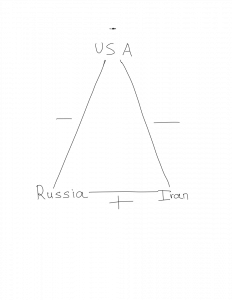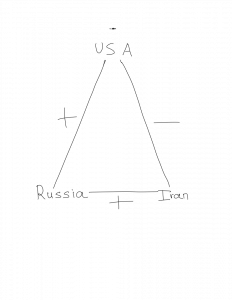Structural Balance Property and its Diplomatic Implications
International relations and diplomacy are a good representation of a complex and interconnected global network. International relations are not just a representative of a simple network graph, but also one for network graphs with positive and negative edges, directional edges and further additional nuances. The United States has been one of the most dominant presence in international diplomacy and international relations. The U.S. has had its fair share of controversial foreign policy decisions. The U.S. has not always had positive relations with notable examples like countries in the Middle East and The Russian Federation. The U.S. has had especially contentious relations with The Islamic Republic of Iran and Russia. Unsurprisingly, and in accordance with the Structural Balance Property, The Russian Federation and The Islamic Republic of Iran have good relations. Tehran, the capital of Iran has Russian contractors developing its nuclear capabilities. Russia has sold arms and ammunition worth over 5 billion USD to Iran over the past decade. Russia has used Iran as its pawn to promote its “obstructionist” foreign policy in the middle east. On the other hand, the U.S. has slapped both Russia and Iran with sanctions independently and through the UN. With President Obama personally and publicly attacking Russia’s poor human rights record and their failing economy along with his governments great effort to prevent Iran from getting a nuclear weapon are indicative of the sore relations the U.S. holds with these two countries. As it stands, the three countries share the following relations among themselves:
The network given above does indeed satisfy the Structural Balance Property. This is the usual state of relations between the US, Russia and Iran. However, the three countries don’t always agree or disagree with each other. From time to time, issue to issue, the temporary relations between the three countries kept changing. This is especially visible with Russia’s changing stances. Russia, while on most occasions stood with Iran, sometimes changed its position to align with the US and most of the UN to suit its own interests. For example, when opening the first nuclear power plant, the Iranians wanted the plant operational in the late 90’s. However, Russia, citing American concerns, delayed opening up the plant until 2013. This way, they made money off of their contract with Iran without having do any work. This helped Russia’s nuclear industry stay alive, in a time of acute funding crisis. Another example of Russia conveniently changing sides is when Iran ordered 800-million-dollars worth of land to air missiles from Russia. In this case, Russia again delayed the delivery of these missiles to suit their financial situation better. However, with these temporary changes in position, the three countries’ relations don’t satisfy the Structural Balance Property in the following way:
However, this instability is once in while quickly corrected, as Russia quickly reverts back to playing the anti-USA role. This instability combined with the U.S’s eternal negative relations with Iran is possibly a reason Moscow and Washington could never really mend broken bridges.
This analysis of international policy and diplomacy is directly a derivative of the Structural Balance Property which we covered in class. As we can see, a simple and straightforward property for 3 nodes and positive/negative relations can tell us a lot about a precarious international situation as the one discussed.


